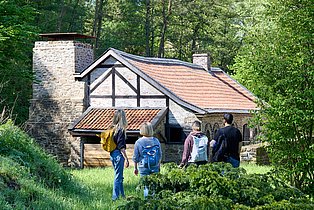
500 years of nature and man: the Deilbach Valley is one of the most exciting industrial cultural landscapes in Europe and one of the oldest museum and monument ensembles in Germany. It has a five-hundred-year history that impressively demonstrates the dynamic interplay between nature and man.
With its soil, historical and technical monuments, it presents all stages of development from a rural to an industrial to a post-industrial landscape in rare unity and at the original locations. As an early industrial monument landscape, it vividly describes the beginnings of the iron and metal industry in the Ruhr region and forms the counterpart to the Zollverein UNESCO World Heritage Site, which stands for the peak of industrialization.
The city of Essen, the Freunde und Förderer des Deilbachtals e. V. and the Ruhr Museum are jointly committed to the future development of the historic monument area and to communicating it through exhibitions, forging demonstrations, walks, guided tours, workshops, etc.
Flying sparks and hammer blows: The Deilbachhammer is the last remaining iron hammer in the Ruhr area at its original location and is also part of the Deilbachsteig. It consists of the foreman's house, the workers' house and the hammer building. The great tradition of blacksmithing is presented during regular forging demonstrations. At the blazing fire in the forge, the blacksmiths explain how the hammer works and shape the glowing iron - hammer blow by hammer blow. A fascinating experience of craftsmanship and the precise technique of a centuries-old art.
The free blacksmithing demonstrations take place regularly from May to September on the 3rd Sunday of every monthfrom 2 to 6 pm. The permanent exhibition in the Kupferhammer is also open free of charge from 12 noon to 6 pm during the blacksmithing events.
Out and about in the Deilbachtal: The Deilbachtal cultural landscape brings together agricultural and early industrial monuments and combines them with a natural landscape - perfect for discovering on foot.
With the Kupferhammer as the starting and finishing point of the guidedhike, it takes three hours to reach twelve natural and cultural monuments. The tour takes in the visible evidence along the way, such as the Hundebrücke bridge, the Deilbachhammer, the former Victoria colliery, the Deiler mill and the Deilmann farm. The natural history of the valley can also be experienced along the way.
The coal seams on the slopes made it possible to mine coal. Ore, sandstone and slate formed the raw materials for other industries. Extensive forests provided wood for the production of charcoal, which was needed for metal smelting. The water of the Deilbach stream was used to power hammers and mills. A hike through a lively valley where people still live, work, cultivate and research to this day.
Dates and information about the hikes can be found here.
Alternatively, the hike can also be booked for groups and combined with a visit to the Kupferhammer or Deilbachhammer. Information is available from the visitor service.
Discover history: Another core object of the cultural landscape is the ensemble of the historic copper hammer. In the former director's room, the permanent exhibition tells the fascinating story of the natural and cultural landscape of the Deilbach Valley using historical maps and photos as well as interesting objects and models. Over 500 years of natural and cultural history can be discovered in the historic rooms.
Between May and September, the permanent exhibition is open free of charge on the 3rd Sunday of every month from 12 noon to 6 pm. On this day, there are always forging demonstrations in the Deilbachhammer from 2 pm to 6 pm.
Otherwise, the exhibition can only be visited as part of a booked guided tour. The guided tour can then be combined with a hike through the Deilbach valley. Information is available from the visitor service.
The workshop for children aged 9 to 12 at the Deilbachhammer is all about the "power of water". In the past, the power of the Deilbach stream was used to set the heavy forging hammer in motion. During the 3-hour workshop, participants will first take a close look at the huge hammer building and then build a hydroelectric power station to take home with them.
Dates and information about the workshop can be found here.
You can find out how to get to us and our locations here.
Further information about the branch office can be downloaded here as PDFs: